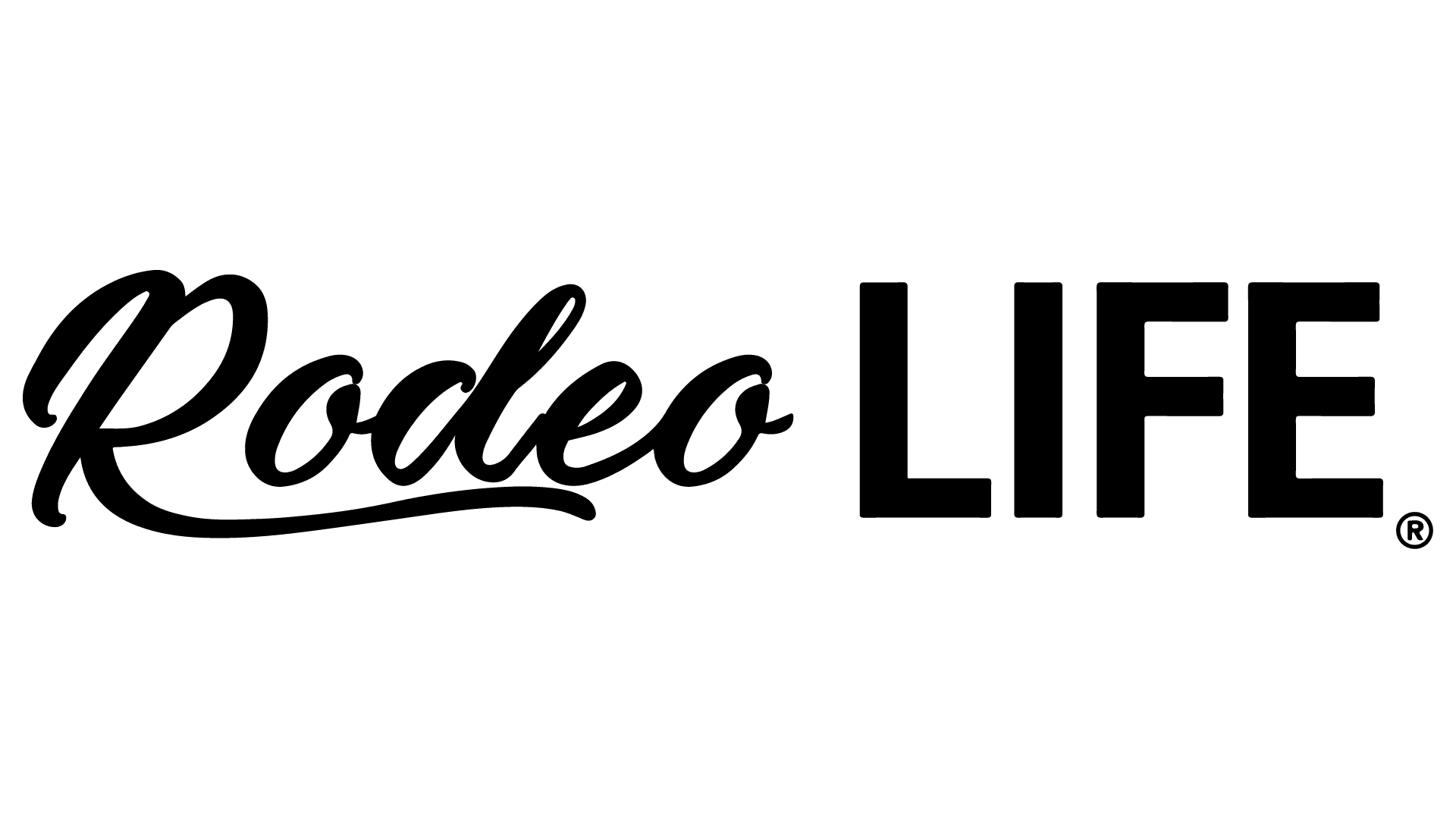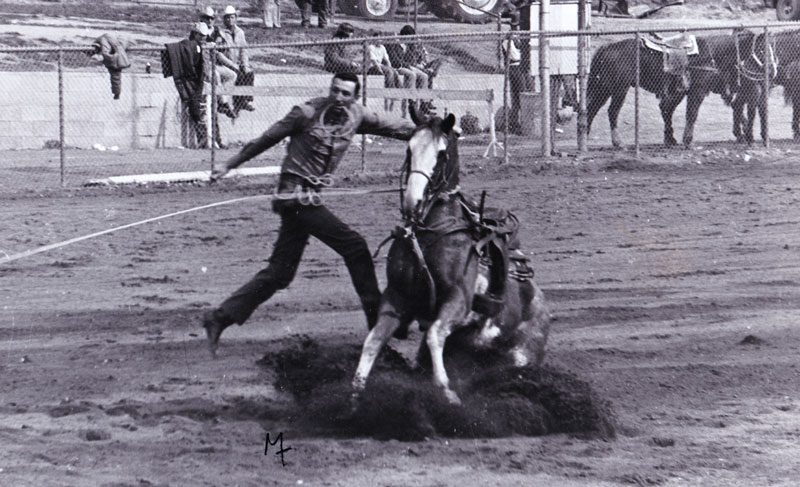Cranberries are about the farthest thing you can think of from rodeo – and yet – one of the most interesting, versatile and capable cowboys for the last sixty years has had both cranberries and rodeo as primary interests in his life. Mel Potter is a cranberry farmer – a proven professional roper – a stock contractor – and breeds, raises and trains some of the top horses in the rodeo arena.
Here is Mel’s story: Granddad Melvin Potter began raising cranberries in Wisconsin in 1880. The family marsh where cranberries come from is still in operation today. His son, Roy, followed in his footsteps, as did Roy’s son, Mel Potter. The cranberry business goes dormant during the winter. As Mel says, “Wisconsin is like Siberia in the winter.” The cranberries are frozen in the marsh during the winter, but when spring comes the cranberries come back to life. Mel’s family also raised mink, and that could have been the catalyst for why Mel got an Animal Science degree from the University of Arizona.
Mel was born in 1935 to Roy and Josephine Potter. When he was 9 his family began spending the winters in Arizona. Mel went to school in a two-room school with twenty other students in grades 6th through 7th. Back in Wisconsin all of Mel’s contemporaries were into the regular sports – baseball, basketball and football. But at Mel’s school in Arizona the kids at school rode horses and roped or rodeo’d as often as they could. It was not surprising that Mel took up roping and team tying (which was big in Arizona at that time). He even rode a few bulls. He knew he wanted to be a cowboy. Mel competed in 13 Junior Rodeos and during high school he qualified for the 1951 High School National Finals, held in Sulphur, Louisiana.
At rodeos in Arizona, Mel watched the ropers from that area that always won – John Rhoades, Lynn and Chuck Sheppard. Mel was all ready competing at area Rodeo Cowboys Association (RCA) rodeos. He said at that time RCA would let non-members compete, but if you started winning any money you had to join. Mel was only 16 when he started winning, so he joined in 1951.
Mel and Wendy were married in 1954. They went off to the University of Arizona where Mel was on the rodeo team. He won the All-Around at the University of Arizona rodeo when he was a senior. They have two daughters, Jo Lynn Alexander, born in 1958 and Sherry born in 1975.
After graduation Mel and a friend, Russ Gregg, got the bright idea to travel back up to Wisconsin and compete in some of the rodeos there. They thought all the ‘toughs’ (top winning cowboys)) would be at rodeos in other locales, not Wisconsin. They just knew they could win lots of money. It was quite a shock when they got to their first Wisconsin rodeo at Madison and all the ‘toughs’ were there, too! Mel and Russ joined the labor list at the rodeo and that helped them get paid enough to be able to compete. The biggest surprise is those ‘toughs’ looked after Mel and Russ, and they also got lots of free advice from them, which they appreciated and needed.
As time went on Mel’s roping kept getting better. He qualified in the calf roping event for the first National Finals in 1959. He won the 5th go-round and won $434 at the Finals. After the Finals he went home in Wisconsin. He realized he had a worn-out stationwagon, a horse trailer that needed new tires, a crippled horse, and enough money from his winnings to enter maybe seven or eight rodeos. His dad, who Mel described as a hard-headed businessman, said, “What do you think of rodeo now?” That’s when Mel decided to go in the cranberry business. However, he continued to compete in rodeos. In fact, he learned to fly so he could get to more rodeos and still be able to work. He also moved his legal residence to Arizona.
A few years later Mel, Jack Brainard and John Snow decided that the big money in rodeo was in the stock contracting business. Brainard had learned a great deal about stock contracting by being associated with stock contractor Leo Cremer, from Montana. Both Mel and Jack had competed and John was a rodeo announcer. The three men started a new company in 1964 named Rodeo, Incorporated (Rodeo, Inc.). They heard Oral Zumwalt, a well-known stock contractor from Missoula MT, was selling out and they purchased 10 good broncs from his string. Most of Rodeo Inc’s rodeos were in the mid-west as well as State Fairs in Indiana, Illinois, Kentucky, Iowa and Minnesota.
Mel said, “One day I got a call from Feek Tooke, who said he had some horses we could use. I had never heard of Tooke and I called my friend, Bill Linderman, President of RCA, and ask him about Tooke. Bill said, ‘If you can get his best horses you’ll have the best bucking stock in the business. But I think he’d rather sell you his wife than his horses.’” The three partners flew up to Ekalaka, Montana and Tooke showed them his horses. He knew all their breeding and history. Tooke said, “These are my best old horses, and he pulled out 20 for them to buy.” Tooke said he would take $500 a horse. As the three owners of Rodeo, Inc. stood there figuring out how they would borrow the money, Tooke said: “Boys, just pay me what you can now and pay the rest when you make it.” And with a handshake the deal was made.
“We bucked ‘em at our first rodeo after that and they darn near bucked every cowboy off, no matter who they were. They were rank broncs. The first year we had them we sent six to the National Finals,” explained Mel. In 1966, Rodeo, Inc. had the NFR Top Saddle Bronc, Tea Trader. Their bronc Sheep Mountain got that honor in 1967. Major Reno was Top Saddle Bronc for 1968 and for 1969 Major Reno tied with Big Bend’s Trade Wind for Top NFR Saddle Bronc. They were all Feek Tooke bred broncs. “All the breeding programs in professional rodeo, at that time, except Kesler, were out of Feek’s horses. He sent us horses two more times, which were top rate. We were lucky to have had such a relationship with him. I was a pall bearer at his funeral,” said Mel.
“On one of the flights back from Feek’s we didn’t know exactly where we were but we saw a rodeo being held. We landed and it was Mobridge, North Dakota. We saw a bronc that was so good, named Chief Crazy Horse, we bought him for $127.50. He was one of the best we ever owned, too. We were stock contractors for ten years before we had out dispersal sale, during the National Finals. I never worked so hard at anything as I did then. But I learned so much during those years. The last three years we made money and had some great rodeos,” Mel laughed. “I feel like I’ve been on vacation ever since.”
When asked, Mel said Dean Oliver and Jess Goodspeed were two of his biggest competitors. “Jess Goodspeed taught me how to beat the top guys,” admitted Mel. “He bought some of the best calf roping horses.” Other competitors he mentioned were Toots Mansfield, Roy Cooper, Don McLaughlin, and Cody Ohl. For steer roping he named Guy Allen and Shawn Burchett.
Mel admits when he first began contesting he didn’t realize how important the horse was in roping. He learned quickly having a good horse was a necessity. Mel’s first horse, at age 16, was Pal, an unregistered gelding out of Oklahoma Star and a Bert mare (both sire and dam are in the AQHA Hall of Fame). In time Mel observed that 50 to 60% of the cowboys in timed events were riding horses that came from Driftwood, an AQHA Hall of Fame horse. His friend, Dale Smith, allowed him to compete on his great horse, Poker Chip, from the Driftwood strain. Mel realized then how much a great horse can improve one’s ability to win.
The Potter Ranch in Marana, Arizona, is well known in the horse industry as being a top Driftwood breeding ground. Mel and wife, Wendy, are partners. They married in 1954 and have two daughters. Jo Lynn Alexander, who was an All-Around Cowgirl in High School, and Sherry Petska, World Champion Barrel Racer four times. Wendy also barrel raced and qualified for the 1970, ’71 and ’72 National Finals.
Mel first bred his roping horse, Red Ghara (a Bert mare) to Speedywood, a son of Driftwood, which produced Speedy’s Redwood, (they nicknamed “Charlie”). The colt’s ability at a young age was just what Mel was looking for. He has been quoted as saying Driftwood genes produce early maturity coupled with longevity and speed. There have been numerous well-known and successful Driftwood bred horses, from Potter breeding, in the past 50 plus decades. Mel says Dinero is probably the best horse he ever bought. Dinero has had 18 horses go to the PRCA National Finals over the years in barrel racing, team roping and steer wrestling. Hailey Kinsel’s great horse, DM Sissy Hayday, better known as ‘Sister, is Dinero bred. Daughter Sherry and husband, Cory Petska have won over $400,000 on Dinero.
Mel admits there came a time when daughter, Sherry, was winning Barrel Racing World Championships he became known as “Sherry’s dad”, in the rodeo, but those things only make him smile. He said her horse, MP Meter My Hay, better known as ‘Stingray’ was probably more famous, at that time, than any of the other great Driftwood horses.
Regardless of the reason why rodeo people know the name Mel Potter, you can bet it’s because of something Mel has done, and done well. He’s been recognized for the good things he has done in the sport of rodeo, the breeding horse world, stock contracting and obviously the cranberry world, too. Potter & Son is one of the largest supplier to the Ocean Spray Cranberry Consortium. “Cranberries allowed me to do these rodeo and breeding activities that I, and my family love so much. I was still roping until two years ago,” said 87 year old Mel.
Back When They Bucked with Mel Potter
48
previous post









